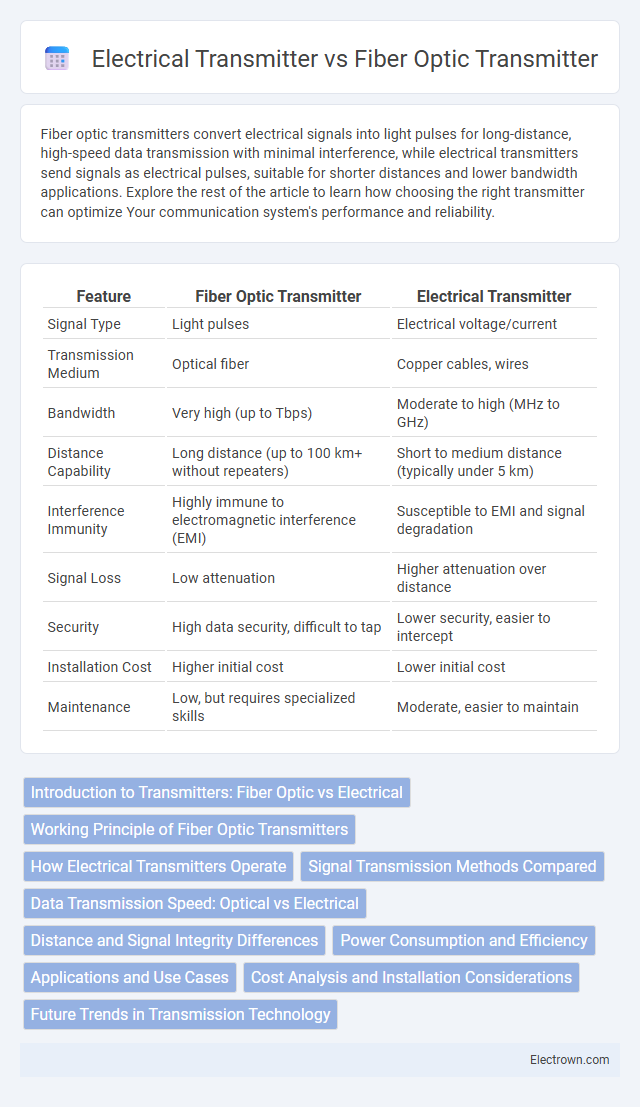Fiber optic transmitters convert electrical signals into light pulses for long-distance, high-speed data transmission with minimal interference, while electrical transmitters send signals as electrical pulses, suitable for shorter distances and lower bandwidth applications. Explore the rest of the article to learn how choosing the right transmitter can optimize Your communication system's performance and reliability.
Table of Comparison
| Feature | Fiber Optic Transmitter | Electrical Transmitter |
|---|---|---|
| Signal Type | Light pulses | Electrical voltage/current |
| Transmission Medium | Optical fiber | Copper cables, wires |
| Bandwidth | Very high (up to Tbps) | Moderate to high (MHz to GHz) |
| Distance Capability | Long distance (up to 100 km+ without repeaters) | Short to medium distance (typically under 5 km) |
| Interference Immunity | Highly immune to electromagnetic interference (EMI) | Susceptible to EMI and signal degradation |
| Signal Loss | Low attenuation | Higher attenuation over distance |
| Security | High data security, difficult to tap | Lower security, easier to intercept |
| Installation Cost | Higher initial cost | Lower initial cost |
| Maintenance | Low, but requires specialized skills | Moderate, easier to maintain |
Introduction to Transmitters: Fiber Optic vs Electrical
Fiber optic transmitters convert electrical signals into light pulses for high-speed, long-distance data transmission with minimal signal loss and electromagnetic interference, making them ideal for modern communication networks. Electrical transmitters send electrical signals over copper cables, suitable for shorter distances but prone to signal degradation and interference. Understanding the differences helps you select the right transmitter type to optimize performance and reliability in your communication system.
Working Principle of Fiber Optic Transmitters
Fiber optic transmitters operate by converting electrical signals into light pulses using a laser diode or LED, allowing data transmission through optical fibers with minimal signal loss and electromagnetic interference. This working principle ensures high-speed, long-distance communication essential for modern networks, contrasting with electrical transmitters that rely on voltage or current changes to send signals over copper cables. Your choice of transmitter affects signal clarity and transmission range, with fiber optic technology offering superior performance for bandwidth-intensive applications.
How Electrical Transmitters Operate
Electrical transmitters operate by converting physical measurements into analog or digital electrical signals, typically voltage or current, which can be easily transmitted over wires to control systems. They rely on sensors that detect changes in parameters such as temperature, pressure, or flow and then generate corresponding electrical signals proportional to these variables. Your control system receives these signals, enabling real-time monitoring and precise process control.
Signal Transmission Methods Compared
Fiber optic transmitters use light pulses to transmit data through glass or plastic fibers, achieving higher bandwidth and longer distance transmission with minimal signal loss and immunity to electromagnetic interference. Electrical transmitters rely on electrical voltage or current signals transmitted over copper cables, which are more susceptible to signal degradation and electromagnetic noise, limiting effective distance and data rates. Optical transmission offers superior performance for high-speed, long-distance communication, whereas electrical transmission remains common for shorter-range, cost-sensitive applications.
Data Transmission Speed: Optical vs Electrical
Fiber optic transmitters leverage light pulses to achieve data transmission speeds reaching terabits per second over long distances with minimal signal loss, outperforming electrical transmitters that rely on electrical signals constrained by resistance and electromagnetic interference. Electrical transmitters typically operate at lower speeds, often limited to gigabits per second, and experience significant signal degradation over extended cables. The intrinsic bandwidth and attenuation properties of optical fibers enable fiber optic systems to support ultra-high-speed and high-capacity data transmissions essential for modern telecommunications and data centers.
Distance and Signal Integrity Differences
Fiber optic transmitters offer superior distance capabilities compared to electrical transmitters, effectively transmitting data over several kilometers with minimal signal loss. Your signal integrity remains higher with fiber optics due to reduced electromagnetic interference and lower attenuation rates, ensuring clearer and more reliable communication. Electrical transmitters are more suited for shorter distances, where signal degradation and interference are more pronounced.
Power Consumption and Efficiency
Fiber optic transmitters consume significantly less power compared to electrical transmitters due to their reliance on light signals rather than electrical pulses, resulting in higher energy efficiency. Their ability to transmit data over longer distances with minimal signal loss reduces the need for power-hungry signal boosting equipment, further enhancing overall power savings. This efficiency makes fiber optic transmitters ideal for high-bandwidth and long-distance communication applications requiring sustainable and cost-effective operation.
Applications and Use Cases
Fiber optic transmitters excel in long-distance telecommunications, high-speed internet infrastructure, and secure data transmission for financial and government sectors due to their immunity to electromagnetic interference and low signal attenuation. Electrical transmitters are widely used in industrial automation, process control, and local area networks where cost-effectiveness and compatibility with existing copper wiring systems are paramount. Both technologies serve critical roles, with fiber optics suited for high-bandwidth, long-range applications and electrical transmitters optimized for short-range, lower-cost environments.
Cost Analysis and Installation Considerations
Fiber optic transmitters generally have higher initial costs due to advanced technology and specialized equipment but offer lower maintenance expenses and longer lifespan compared to electrical transmitters. Installation of fiber optic systems requires skilled labor and careful handling of delicate fibers, resulting in higher upfront labor costs, while electrical transmitters benefit from simpler installation with existing infrastructure compatibility. Your choice should balance long-term cost savings from fiber optics against the immediate affordability and ease of deploying electrical transmitters.
Future Trends in Transmission Technology
Fiber optic transmitters are rapidly advancing with higher data rates and longer transmission distances, enabling more efficient and scalable network infrastructures in the future. Electrical transmitters, while still relevant for short-range and legacy systems, face limitations in bandwidth and signal degradation over long distances. Your choice will increasingly favor fiber optic technology as next-generation transmission technologies emphasize speed, reduced latency, and enhanced reliability for expanding data demands.
Fiber Optic Transmitter vs Electrical Transmitter Infographic

 electrown.com
electrown.com